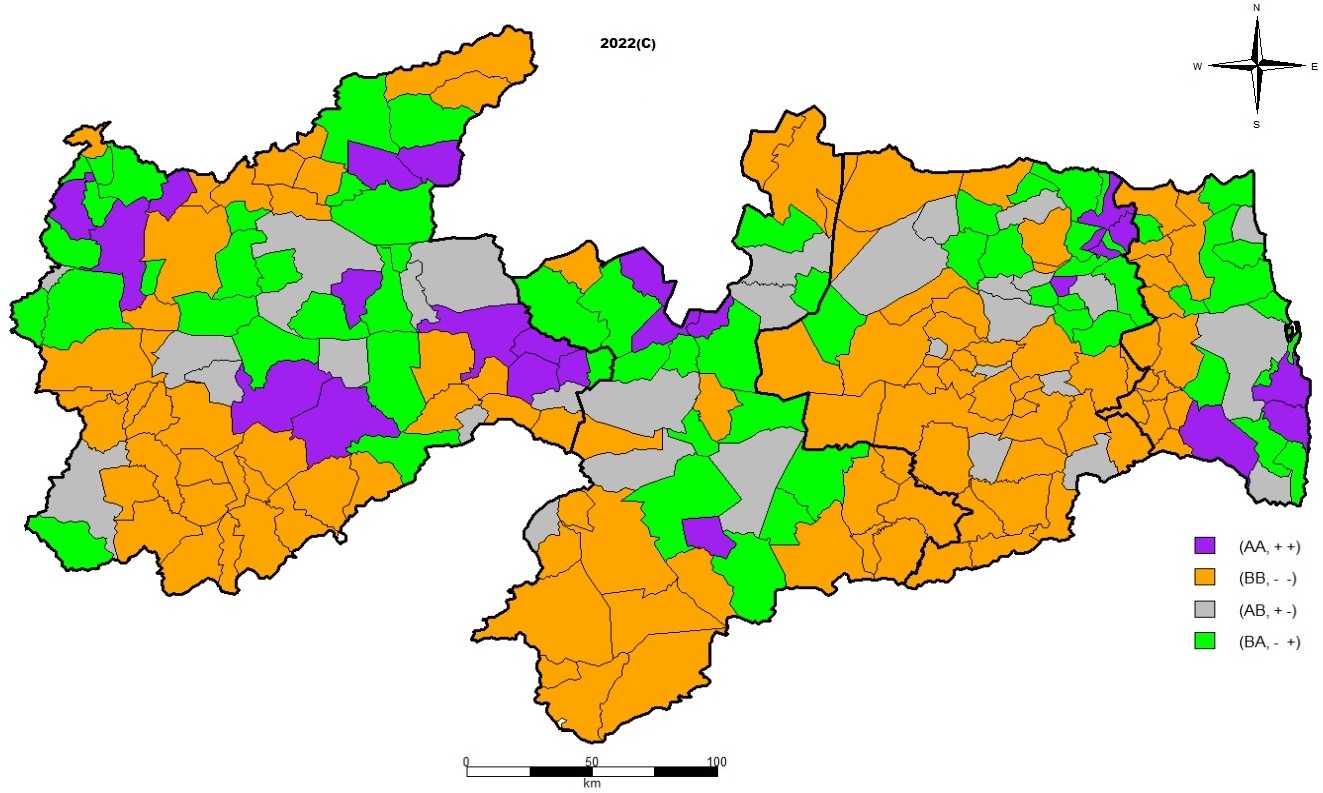Spatial Analysis of dengue cases in the state of Paraíba, Brazil
an application with RIE
Keywords:
SIR, SAR, Spatial StatisticsAbstract
This research presents an analysis of the dissemination of dengue, transmitted by Aedes aegypti, commonly known as the dengue mosquito. The study highlights the global increase in cases over the years, with a significant rise in Brazil, specifically in Paraíba. The research aims to analyze the distribution of reported dengue cases in the years 2015 and 2022 in the State of Paraíba using spatial statistical methods, considering socioeconomic and environmental factors. Moran indices were used to test spatial dependence, and maps such as Box Map, Lisa Map, and Moran Map were employed to visualize spatial associations. A Spatial Autoregressive (SAR) regression model was applied to assess the influence of independent variables on the Spatial Incidence Ratio (SIR). The results suggest spatial autocorrelation in the SIR and highlight the significance of the variables (Municipal Human Development Index and Per Capita Income) in the SAR 4 model
References
AKAIKE, H. Information theory and an extension of the maximum likelihood principle. Selected papers of Hirotugu Akaike, Springer, p. 199–213, 1998.
BIVAND, R. S.; GÓMEZ-RUBIO, V.; RUE, H. Approximate Bayesian inference for spatial econometrics models. Spatial Statistics, v. 9, p. 146–165, 2014.
DUNCAN, D. T.; KAWACHI, I.; MELLY, S. J.; BLOSSOM, J.; SORENSEN, G.; WILLIAMS, D. R. Student column demographic disparities in the tobacco retail environment in Boston: A citywide spatial analysis. Public Health Reports, SAGE Publications Sage CA: Los Angeles, CA, v. 129, n. 2, p. 209–215, 2014.
FERREIRA, G. S.; SCHMIDT, A. M. Spatial modelling of the relative risk of dengue fever in Rio de Janeiro for the epidemic period between 2001 and 2002. Brazilian Journal of Probability and Statistics, v. 20, n. 1, p. 29–47, 2006.
FISCHER, M. M.; WANG, J. Spatial data analysis: models, methods and techniques. [S.l.]: Springer Science & Business Media, 2011.
KARAM, H. A.; SILVA, J. C. B. da; FILHO, A. J. P.; ROJAS, J. L. F. Dynamic modelling of dengue epidemics in function of available enthalpy and rainfall. Open Journal of Epidemiology, Scientific Research Publishing, v. 6, n. 1, p. 50–79, 2015.
LIMA, L. M. M. de; SA, L. R. de; MACAMBIRA, A. F. U. dos S.; NOGUEIRA, J. de A.; VIANNA, R. P. de T.; MORAES, R. M. de. A new combination rule for spatial decision support systems for epidemiology. International journal of health geographics, BioMed Central, v. 18, n. 1, p. 1–10, 2019.
LOCH, R. E. N. Cartografia: representação, comunicação e visualização de dados espaciais. [S.l.]: UFSC, 2006.
MORAN, P. A. Notes on continuous stochastic phenomena. Biometrika, JSTOR, v. 37, n. 1/2,
p. 17–23, 1950.
NEIVAS, G. S.; BAPTISTA, A. C. Análise exploratória de dados espaciais da violˆencia contra lgbtqia+ no brasil. Rev. Bras. Cartogr, v. 74, n. 1, 2022.
OLIVEIRA, A. A. de; MONTEIRO, J. B.; SANTIAGO, D. de B.; MOURA, D. C. Variabilidade climática e casos de dengue em cidades do estado da Paraíba, Brasil. Research, Society and Development, v. 11, n. 11, p. e50111133256–e50111133256, 2022.
PERMAI, S. D.; JAURI, R.; CHOWANDA, A. Spatial autoregressive (SAR) model for average expenditure of Papua Province. Procedia Computer Science, Elsevier, v. 157, p. 537–542, 2019.
PINTO, M. M. P. S.; SA, L. R. de; SOARES, R. A. S.; MEDEIROS, A. T. de; NOGUEIRA, J. de A.; MORAES, R. M. de. Análise comparativa de métodos de aglomeração espacial para estudos epidemiológicos. Revista Espa¸co e Geografia, v. 22, n. 1, p. 683–706, 2019.
R CORE TEAM. R: A Language and Environment for Statistical Computing. Vienna, Austria, 2021. ⟨https://www.R-project.org/⟩.
RAMOS-CASTANEDA, J.; SANTOS, F. Barreto dos; MARTINEZ-VEGA, R.; ARAUJO, J. Galvão de; JOINT, G.; SARTI, E. Dengue na américa latina: Revisão sistemática das tendências epidemiológicas moleculares. PLoS Neglected Tropical Diseases, v. 11, p. 1, 2017.
SILVA, E. T. C. d.; OLINDA, R. A.; PACHA, A. S.; COSTA, A. O.; BRITO, A. L.;
PEDRAZA, D. F. Spatial analysis of the distribution of dengue cases and its relationship with socio-environmental factors in the state of Paraíba, Brazil, 2007-2016. Saúde em Debate, SciELO Brasil, v. 44, p. 465–477, 2020.
TAN, L. K.; LOW, S. L.; SUN, H.; SHI, Y.; LIU, L.; LAM, S.; TAN, H. H.; ANG, L. W.; WONG, W. Y.; CHUA, R. et al. Force of infection and true infection rate of dengue in singapore: implications for dengue control and management. American journal of epidemiology, Oxford University Press, v. 188, n. 8, p. 1529–1538, 2019.

Downloads
Published
How to Cite
Issue
Section
License
Proposta de Política para Periódicos de Acesso Livre
Autores que publicam nesta revista concordam com os seguintes termos:
- Autores mantém os direitos autorais e concedem à revista o direito de primeira publicação, com o trabalho simultaneamente licenciado sob a Licença Creative Commons Attribution que permite o compartilhamento do trabalho com reconhecimento da autoria e publicação inicial nesta revista.
- Autores têm autorização para assumir contratos adicionais separadamente, para distribuição não-exclusiva da versão do trabalho publicada nesta revista (ex.: publicar em repositório institucional ou como capítulo de livro), com reconhecimento de autoria e publicação inicial nesta revista.
- Autores têm permissão e são estimulados a publicar e distribuir seu trabalho online (ex.: em repositórios institucionais ou na sua página pessoal) a qualquer ponto antes ou durante o processo editorial, já que isso pode gerar alterações produtivas, bem como aumentar o impacto e a citação do trabalho publicado (Veja O Efeito do Acesso Livre).
